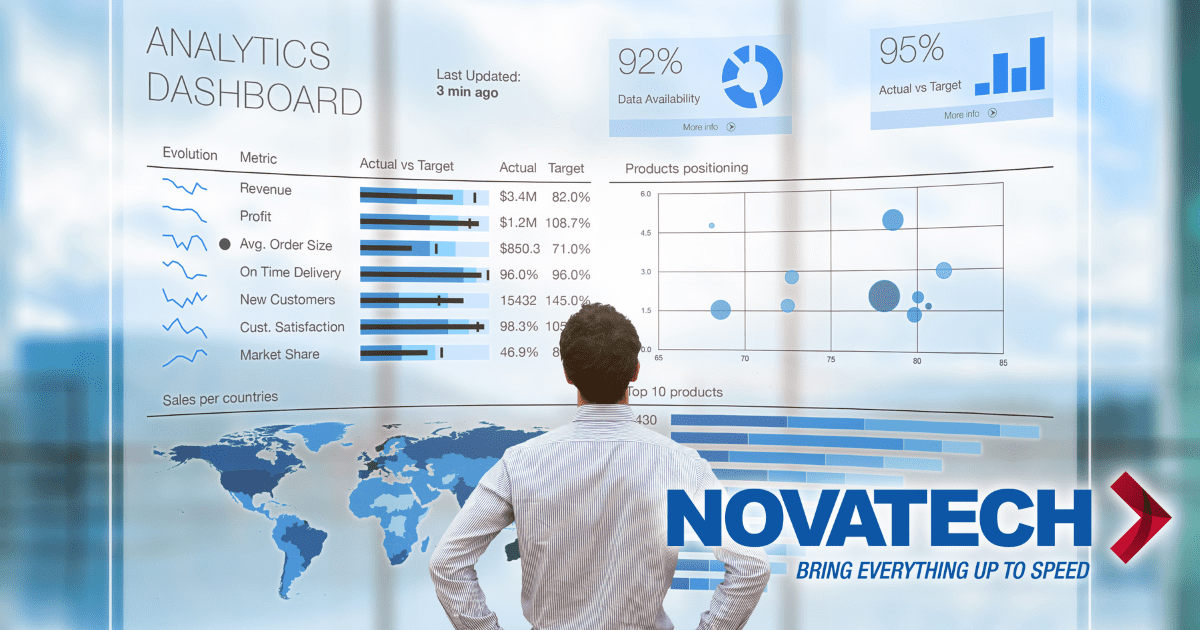What Data Analytics Can Do For Your Business
5 min read

If you are a business with a bulk of its data stored on servers which contains information about your orders, inventory, customers, or other critical business data, you should consider employing a data analytics strategy for your company. Using Business Intelligence (BI) can give you a leg up on competitors by providing insights into waste and opportunity that might not be easily identified by a manager or leader in your company.
At Novatech, we won’t only help you implement a sound Business Intelligence strategy, we use BI for our own business and have our own in-house team to help our business grow and stay ahead. We can help you connect your data to a dashboard which makes visualization and decision making for your organization faster and easier.
Business Intelligence is for every business at one level. Taking your current system and quickly being able to filter and analyze this data is what can give you a competitive advantage. BI as a service, generally requires a stronger commitment to data analytics, as well as a budget to support the building and maintaining of the BI platform you will be using.
How Data Analytics Has Become a Key Business Driver
Throughout the history of the American business sector, the competitive edge that companies need to thrive has been influenced by trends. In the 1980s, for example, companies made it a point to allow customers and audiences to know that they were actively using emerging technologies such as electronic bulletin board systems. In the 1990s, customer relationship management (CRM) systems determined which companies would become market leaders. In the first decade of the 20th century, early e-commerce adoption was seen as a highly competitive business move; the next decade was all about the customer journey and the use of social media.
A few years ago, the field of business intelligence became intermingled with data science; this was a result of the natural progression and advancement of database technology. Around 2005, we started seeing more reports about Big Data and how it was a trend shaping the future of business competition. These days, the principles of Big Data collection and analytics are no longer associated with large enterprise companies. In 2023, a small business with a couple of employees could embrace the power of data analytics. All companies generate information ripe for evaluation and analysis.
The bottom line of data analytics in 2023 is as follows: If you see your main competitors rapidly expanding and grabbing a larger market share, chances are that their decisions are being made according to actionable insights gleaned from data analytics. In other words, not paying attention to data analytics could be why competitors are getting ahead of you.
Data Analytics as a Business Process
If we consider data analytics as a set of processes that help to improve business operations as well as other processes, then all companies are already data-driven. In the case of accounting, for example, all that is required to maintain accurate records is good old-fashioned pencil and paper data entry, a process that can be completed manually but is largely handled through software applications such as QuickBooks, Zoho, or Dynamics, for greater efficiency, accuracy, and insight.
Depending on how your account is configured, you may see an insights or reporting tab on the desktop version. When you access your insights, you are looking at data analytics split into three sections: Income, Expenses, and Reports. When you look at these sections, which display charts for visualization, you get a snapshot of the company’s finances, and you should base your next moves based on this information.
Keep in mind that the data collection, organization, reporting, and visualization processes were automated by your accounting platform.
Data analytics is as vital to modern business operations as accounting. Business owners who are not familiar with data analytics tend to be concerned about the data collection process, but this is not an obstacle at all. Data generation happens almost naturally these days because the modern workplace is primarily digital.
Think about old documents, reports, spreadsheets, and other files that may be in archived directories of your office servers. This could be a business data goldmine that you can use for analytics. How are you using the data you have stored? Does it require a person to go look for a specific document, or does it feed a dashboard to help you make more informed decisions?
Using Data Analytics to Identify Issues
If you feel that competitors are getting ahead of you without making much of an effort, you may be operating with inefficiencies that can only be identified through sensible data analytics. There is a good chance your competitors have already gained insights to spot inefficient processes and correct them as needed. They use these insights to increase their efficiencies and reallocate resources for sales and marketing efforts, or just send those savings to their bottom line.
Everything from slow deliveries to internal fraud and from premature spoilage to redundancies can be discovered through data analytics. None of these findings are obvious at first glance; whenever issues are flagged through an algorithm or analytic scenario comparisons, chances are that business owners or managers would never have caught them. This is a fancy way to say the algorithm helps show the manager when something is off or not expected based on the total data in the system.
Spotting operational deficiencies or red flags is just one of the many benefits of data analytics. The goal is to improve the long-term outlook of the company. Strategies based on data analytics tend to improve over time as more data is gathered. One weakness can be making decisions too quickly before sufficient data has been collected. Our team will help you understand the best practices and confidence you should have in your dashboards from the initial setup until the dashboard is reporting exactly the data you need to make the best business decisions.
The basic steps of the data analytics process are:
- Collection – Getting data into a system
- Organization – Deciding how to organize the data into metrics
- Evaluation – Looking at the metrics to see how the business is performing
- Integration – Making changes in your company based on these metrics
To make data analytics a valuable priority for your business in 2023, please feel free to contact Novatech so that we can discuss your options. We would love to help your company realize all the amazing benefits data analytics can offer your company.


